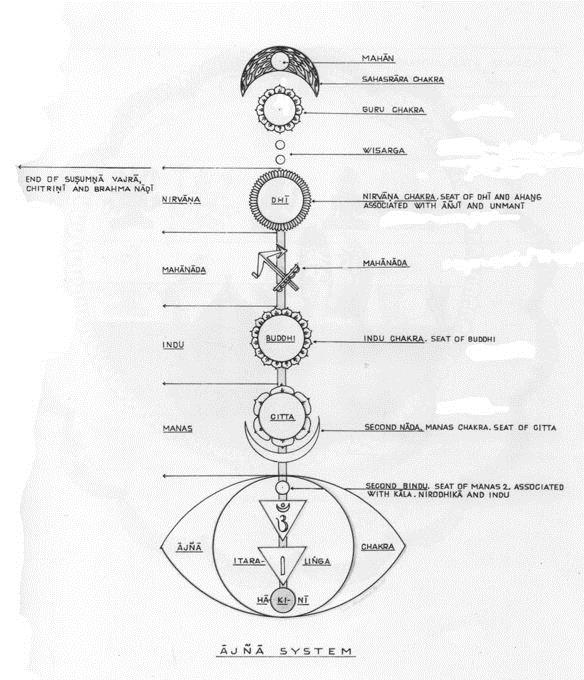



10 Oct 19
© Malvin Artley
(from a posting on a closed social media forum a few years ago)
We are told about the three major centers in the head in the books of Alice Bailey—the crown, ajna and alta major centers. We are also told there are seven centers in the head, though we are not told what these four other centers are or where they are located. There is scant information on these other four centers on the internet, either. However, there is a book out that lists these four centers, and in fact all the centers in detail and the information contained in that book confirms what we are given in DK’s material if we care to dig a little. This short paper is a brief exploration of those centers and especially their relationship to the seven major chakras with which we are familiar.
The seven major chakras are as follows, with the Sanskrit names and basic functions/appearance:
|
Base |
Muladhara |
4 petals |
Kundalini/will-to-live |
Blood-red |
Earth Indra/Brahma The Fierce Woman |
|
Sacral |
Svadhisthana |
6 |
Duality/elemental mind |
Vermillion-red |
Water Varuna |
|
Solar Plexus |
Manipura |
8/10 |
Emotional response/instinctive mind |
Black, dark green, dark blue |
Fire Wahni/Rudra |
|
Heart |
Anahata |
12 |
Life principle, unitive mind (love) |
Deep rose-red |
Winds (prana/air) Wayu |
|
Throat |
Vishuddha |
16 |
Creative mind |
Shining smoke-colored |
Void/space (ether) Ambara |
|
Brow |
Ajna |
2 |
Integrative mind |
Yellow (moon-colored). The most intense white in concentration |
Chitta Hakini |
|
Crown |
Sahasrara |
1000 |
Transcendence of mind/universal mind |
Variegated, all colors |
Universal mind/supreme emptiness Parama Shiva |
In addition, there is another chakra between the solar plexus and the heart, just under the heart called ‘Hrit’, which has 8 petals, gold in color, and which is a special center for concentrative practices. It normally points downward, but should be raised upward in concentration. In addition, we have the alta major chakra, with characteristics as follows, as above:
|
Alta Major |
Talu |
12 or 64 |
Special meditations on emptiness (only under instruction) |
Red when 12 Shining white when 64 |
Nectar/bliss No deity listed |
Then we finally have the four subsidiary chakras in the head, three of which are listed as part of the ‘ajna system’, the last being of the shasrara, but which are actually synthesized by the talu/alta major chakra, again as above:
|
Manas |
6 |
Absorption of chitta (withdrawal from the senses) Concentration here opens the third eye |
White |
Sense-mind Concrete mind |
|
|
Buddhi (Indu, also Shitang-shu) |
Indu |
16 |
Near-attainment Between buddhi and nirvana chakras is a nadi controlling the stoppage of the breath. |
Moon-colored |
Intellective mind (as in deep contemplation) Vipassana Intuition/Insight Parashiva |
|
Nirvana |
Mahankara |
100 |
Samprajnata samadhi Union of meditator and ‘other’ |
Shining white |
Supreme consciousness Shiva |
|
Guru Lower aspect of sahasrara |
Prakriti |
12 |
Transcendence |
Pure crystalline white |
Supreme being The guru (specifically, emulating the qualities of the guru) Emanation |
The question naturally arises as to why these transcendent chakras are not mentioned in the Bailey books or elsewhere in the Western esoteric literature and why information is available now to the West. Also, what use might we make of the information? One thing that stands out when looking at the information about these chakras is that they are intimately involved in and activated during the processes of initiation. They have been, up until recently, secret. As such, the needed information about them in terms of activating them and working with them is lacking, because it is in the domain of verbal instruction and is safeguarded for both the student and the ashram. Consideration of a few points will bear this out.
Firstly, why would the alta major chakra, lying at the base of the brain, serve to synthesize these higher centers? There is a blind in that, I think. What is ruled in terms of human physiology at the base of the brain in the medulla oblongata?—heartbeat, breathing, automatic functions in the body, and waking/sleeping consciousness. What happens when our consciousness is focused in these four other chakras?—withdrawal of the consciousness from the body, automatic control (stoppage) of the breathing, entry into altered states of consciousness (as in dreaming during sleep), etc. I would be willing to say that the alta major represents a synthesis of these centers. However, there is more.
The special meditations mentioned in connection with the alta major center concern the generation of what is termed ‘great bliss’ in Vajrayana practices. Vajrayana practices require a guru for activation and for guidance in the later stages of those practices for safety. At least, that has been the case up until now, and probably will be into the future. However, if a person’s karma is such that they have done such practices in the past, there can be spontaneous activation of these centers and the alta major in the present life, and I have seen this especially with women. The generation of great bliss, or the downflow of nectar as it is sometimes called, causes the arousal of kundalini (tummo in Tibetan), or ultimate bodhichitta, and kundalini is sometimes called ‘the fierce woman’. It is the serpent of wisdom in physical form and women are connected with the wisdom aspect of the path. There is much here for consideration.
But to the matter at hand, the alta major center brings the whole range of breathing practices (‘practices’ being the operative term) into focus. Through breathing exercises the mind is stilled (manas center is activated). Through the generation of bliss, buddhi is contacted, activating the buddhi center. Once the practices become automatic in conjunction with bliss, the nirvana chakra is brought into activity. We can perhaps get a sense as to why these centers were never mentioned previously, because to play with these things without guidance is dangerous. But perhaps we get a little insight. These are the things that stand out to me at the moment, although there is a wide range of discussion to be had. And we have not even touched on planets, rays, colors, etc.
There is another point to this, though. I think there is another reason this information is becoming known now, and it has to do with the process of externalization of the ashrams. If DK’s previous incarnation is as some on this forum are sensing (and I would agree with them) then this is a realization of great moment, because it intimately links Vajrayana with Western esotericism and it indicates an immanent event. It also indicates the level of human advancement toward the stated goals around 2025, etc, and the readiness of many members of the human family to receive these instructions, rather than the few. Hmmm……
Anyway, here is a diagram of the four minor centers (next page):

Goswami, Shyam Sundar. Layayoga: The Definitive Guide to the Chakras and Kundalini . Inner Traditions Bear & Company (1999-05-01).
These colors are as listed in Layayoga, as are the deities in the column to the right. Colors in chakras are variable, according to one’s state of evolution and meditative advancement, and there are few hard and fast rules to that effect. Any color can be found in any chakra, although there are ‘default’ colors, and this has been born out through consensus of clairvoyant investigation through the years. The same can apply to planetary influences.
8 petals in the manipura chakra are found in more primitive states of development, where life is lived at a very instinctive, survivalist level. In people where the mind is active there will always be 10 petals.






